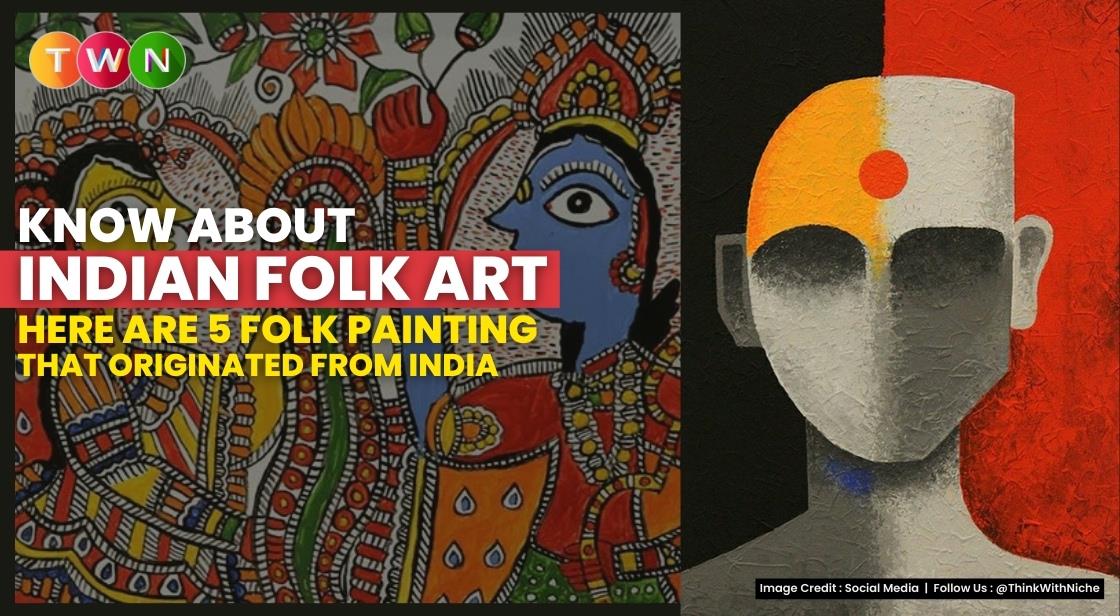Know About Indian Folk Art Here Are 5 Folk Paintings That Originated From India

Blog Post
India is a land of diverse cultures and artistic traditions, and its folk art forms are a testament to this rich heritage. Folk paintings, in particular, reflect the vibrant and colorful essence of Indian culture. Passed down through generations, these art forms have roots in ancient traditions and hold deep cultural significance.
These art forms not only serve as a medium of artistic expression but also carry the stories, traditions, and beliefs of generations. They continue to thrive today, with artists and artisans preserving and promoting these traditional art forms.
By appreciating and understanding Indian folk art, we can celebrate the legacy of these art forms and support the artisans who keep them alive. These paintings serve as windows to India's cultural past and are a testament to the enduring power of art to connect people, transcend time, and preserve heritage for generations to come.
In this article, we will explore five captivating folk paintings that originated from India, namely Madhubani Painting, Pattachitra, Cheriyal Scroll Painting, Kalamkaris, and Pahari Painting. Each of these art forms has its unique style, themes, and historical context, showcasing the diversity and artistic excellence of Indian folk art.
India has a long history of art and art forms, which are unfortunately neglected by Indians, who are oblivious to their rich history and heritage. We have turned a blind eye to the art scene that has always been in India from ancient times because we were obsessed with science.
It's difficult to keep track of all of the different types of folk art and art forms that have emerged from Indian soil. Many art styles, however, have been overlooked.
But fortunately, the wheel of life has kept many other traditional Indian folk art alive. While they may not be popular amongst the masses, they surely have a niche audience that understands it and wants to preserve it for the next generation.
Let's learn about five such traditional and beautiful Indian folk art.
History of Indian Folk Art
Indian folk art holds a significant place in the country's cultural fabric, reflecting the rich tapestry of traditions, beliefs, and artistic expressions. With roots stretching back centuries, folk art in India has evolved and thrived in various regions, communities, and social contexts. This article aims to delve into the fascinating history of Indian folk art, tracing its origins, development, and enduring significance.
Ancient Origins: The Early Expressions of Folk Art
The history of Indian folk art can be traced back to ancient times when communities expressed their creativity through various art forms. Cave paintings found in sites such as Bhimbetka and Ajanta testify to the early artistic endeavors of the indigenous people. These cave paintings, dating back thousands of years, depict scenes of daily life, hunting, rituals, and mythological tales, providing a glimpse into the artistic expressions of ancient India.
Regional Diversity: The Splendor of Folk Art FormsIndia's diverse geography and cultural tapestry have given rise to a multitude of regional folk art forms. Each region has its distinctive style, themes, and techniques, often shaped by the local traditions, customs, and historical influences.
Evolution and Influence: Factors Shaping Folk Art
Over the centuries, Indian folk art has not remained static but has evolved, adapting to changing social, cultural, and historical contexts. Several factors have influenced the development and evolution of folk art:
-
Religion and Mythology: Indian folk art is deeply intertwined with religious and mythological narratives. Art forms often depict gods, goddesses, epics, and legends, serving as a visual medium to communicate and celebrate religious and cultural beliefs.
-
Patronage and Influence: The patronage of rulers, nobility, and wealthy patrons played a crucial role in shaping folk art. The support and encouragement provided by these patrons allowed artists to develop their skills, experiment with new techniques, and create magnificent works of art.
-
Social and Cultural Traditions: Folk art is deeply rooted in the social and cultural traditions of communities. It serves as a means of storytelling, cultural preservation, and community bonding. Festivals, rituals, and celebrations provide platforms for folk artists to showcase their skills and contribute to the cultural fabric.
Preservation and Revival: Nurturing the Legacy
In recent times, efforts have been made to preserve and revive traditional Indian folk art forms. Recognizing the cultural and artistic value of these art forms, organizations, artists, and the government have taken initiatives to provide platforms, training, and financial support to folk artists.
Artists' collectives, craft organizations, and museums have played a pivotal role in promoting and showcasing folk art at national and international levels. Additionally, the integration of folk art into contemporary art practices has led to a resurgence of interest and appreciation for these traditional art forms.
The history of Indian folk art is a testament to the country's rich cultural heritage and artistic expressions. From the ancient cave paintings to the vibrant regional art forms, folk art in India reflects the diversity, traditions, and beliefs of its people. These art forms not only serve as expressions of creativity but also carry the stories, customs, and aspirations of generations.
As we appreciate and support Indian folk art, we contribute to the preservation and continuation of these valuable cultural treasures. By celebrating the history and significance of folk art, we ensure that these art forms continue to thrive, inspire, and connect people across borders and generations.
Also Read: Exploring the Cultural Splendors of Incredible India
Here Are 5 Folk Paintings That Originated From India
1. Madhubani Painting
Madhubani Painting, also known as Mithila Painting, holds a prominent place in the rich tradition of Indian folk art. Originating from the Mithila region in Bihar, India, this art form has a history that dates back to ancient times. Madhubani Painting has been traditionally practiced by women, who pass down their artistic skills and techniques from one generation to the next.
The uniqueness of Madhubani Painting lies in its intricate designs and vibrant color palette. The artists use natural dyes derived from plant extracts, such as turmeric, indigo, and vermilion, giving the paintings their distinctive hues. The colors are often bold and contrasting, creating a visually striking effect.
One of the distinguishing features of Madhubani Painting is the absence of space or background. The entire surface is filled with elaborate patterns, motifs, and figures, which are densely packed and meticulously detailed. The artists employ different techniques, such as double-line borders, decorative elements, and geometric patterns, to enhance the visual appeal of the artwork.
The themes of Madhubani Painting encompass a wide range of subjects. Many paintings depict scenes from Hindu mythology, portraying gods, goddesses, and epic narratives. Popular mythological characters like Lord Krishna, Radha, Shiva, Durga, and Ramayana figures often find their place in these artworks.
Madhubani artists also draw inspiration from nature, showcasing elements like birds, animals, flowers, and trees. Additionally, the paintings often depict scenes from the daily life of rural villages, showcasing activities like farming, festivals, and social gatherings.
Madhubani Painting serves not only as an artistic expression but also as a cultural and social symbol. Traditionally, these paintings were created on mud walls and floors of houses during festivals, weddings, and other auspicious occasions.
The art form served as a form of decoration, bringing color, joy, and auspiciousness to the surroundings. Over time, the paintings started to be created on canvas, paper, and other mediums, enabling wider dissemination and commercialization of this beautiful art form.
In recent years, Madhubani Painting has gained international recognition and acclaim. Artists from the Mithila region have showcased their works in prestigious exhibitions and art galleries worldwide, bringing this ancient art form into the global spotlight.
The uniqueness, intricacy, and cultural significance of Madhubani Painting have captivated art enthusiasts and collectors alike.
Efforts have been made to promote and preserve Madhubani Painting, ensuring its continuity for future generations. Art organizations, government initiatives, and non-profit organizations have provided training, resources, and platforms for Madhubani artists to showcase their talent and earn a livelihood through their art.
These initiatives have not only supported the artists economically but have also played a crucial role in preserving the cultural heritage and identity associated with Madhubani Painting.
2. Pattachitra
Pattachitra, a traditional art form from the state of Odisha in eastern India, holds a significant place in the realm of Indian folk art. The term "Pattachitra" is derived from the Sanskrit words "patta," meaning cloth, and "chitra," meaning painting. True to its name, Pattachitra paintings are meticulously crafted on cloth or palm leaves, using natural colors and pigments.
Pattachitra paintings are renowned for their intricate details and vibrant color palette. The artists, known as Chitrakars, employ fine brushes made from animal hair and create elaborate compositions that depict mythological narratives, religious themes, and local folklore. These paintings are characterized by their rich symbolism, attention to detail, and the ability to convey stories through visual imagery.
The subjects depicted in Pattachitra paintings often revolve around Hindu mythology and folklore. The artists skillfully portray gods, goddesses, and mythological characters like Lord Krishna, Lord Jagannath, Radha, Shiva, and Durga, among others. These narratives are brought to life through intricate brushwork, expressive facial features, and carefully composed scenes that capture the essence of the stories being told.
One of the remarkable aspects of Pattachitra is the unique style in which it is created. The process begins with the preparation of the canvas, which involves treating the cloth or palm leaf with a mixture of chalk and gum made from tamarind seeds. This step gives the surface a smooth texture and allows the colors to adhere effectively.
The artists then sketch the outline of the composition using a fine black line. This outline serves as a guide for the subsequent layers of color that are applied. The colors used in Pattachitra paintings are primarily obtained from natural sources, such as minerals, plants, and stones. The pigments are carefully ground and mixed with natural binders to create a palette of vibrant hues.
The application of colors in Pattachitra is done with precision and finesse. The artists pay careful attention to shading, highlighting, and creating depth to give the paintings a three-dimensional effect. The compositions are often adorned with decorative elements, ornate borders, and intricate patterns, showcasing the artists' exceptional craftsmanship.
Pattachitra has not only served as a visual art form but also as a means of storytelling and cultural expression. These paintings have been integral to religious rituals, festivals, and ceremonial occasions in Odisha. They have adorned the walls of temples and households, infusing spaces with beauty, spirituality, and a connection to tradition.
Over the years, Pattachitra has evolved and adapted to changing times while retaining its core essence. Today, Pattachitra artists are exploring contemporary themes and experimenting with new styles, attracting a wider audience and preserving the relevance of this ancient art form in the modern world.
Efforts have been made to promote and preserve Pattachitra, ensuring its continuity and recognition as a valuable cultural heritage. Art organizations, government initiatives, and cultural institutions have played an active role in supporting the Chitrakars and providing them with platforms to exhibit their artwork. Workshops and training programs are conducted to pass on the knowledge and techniques of Pattachitra to the younger generation, ensuring its continuation for years to come.
3. Cheriyal Scroll Painting
Cheriyal Scroll Painting, originating from the village of Cheriyal in the Telangana region of India, is a distinct and captivating art form that has been passed down through generations. This traditional scroll painting technique is renowned for its vibrant colors, intricate details, and unique storytelling approach.
Cheriyal Scroll Painting is deeply rooted in the cultural and religious fabric of the region. The scrolls are typically made of khadi cloth, a handwoven cotton fabric, and are treated with a mixture of starch and tree gum to give them strength and durability. The artists, known as Nakashi artists, use natural pigments derived from minerals, stones, and plant extracts to create a rich and expressive color palette.
One of the defining features of Cheriyal Scroll Painting is its bold and distinctive style. The artists employ strong black lines to outline the figures and create a sense of depth and perspective. The colors are applied with precision and care, often using vibrant shades of red, yellow, green, and blue to bring the compositions to life. The intricate detailing, expressive facial features, and intricate patterns contribute to the overall visual appeal of the art form.
Cheriyal Scroll Paintings primarily depict mythological stories, folklore, and epic tales from Hindu epics like the Ramayana and the Mahabharata. The scrolls are divided into narrative panels, each depicting a specific scene or episode from the story. As the scroll is unfurled horizontally, the viewer is taken on a visual journey, witnessing the unfolding narrative through each panel.
The artists skillfully narrate complex stories through their paintings, capturing the essence and emotions of the characters and events. The use of symbolic elements and visual cues helps convey the messages and morals embedded within the tales. The scrolls often depict gods, goddesses, celestial beings, demons, and legendary heroes, transporting viewers into a realm of mythology and folklore.
Cheriyal Scroll Painting has not only been a form of artistic expression but also an integral part of cultural and religious ceremonies. The scrolls have been used in storytelling performances, religious processions, and festivals, where they serve as visual aids to narrate the stories to a wider audience. The dynamic nature of the scrolls, with their unfurling panels, adds a sense of drama and engagement to the storytelling experience.
In recent years, efforts have been made to promote and preserve Cheriyal Scroll Painting as a valued cultural heritage. Art organizations, government initiatives, and cultural institutions have played a crucial role in supporting the artists and providing them with platforms to showcase their skills. Workshops and training programs have been organized to ensure the transmission of knowledge and techniques to future generations.
4. Kalamkaris
Kalamkari, derived from the words "kalam" (pen) and "kari" (work), is a mesmerizing traditional art form originating from Andhra Pradesh and Telangana in India. This ancient art form encompasses both hand-painted and block-printed textiles, known for their intricate detailing, rich colors, and captivating designs.
The history of Kalamkari can be traced back several centuries, with its origins rooted in the patronage of the Mughal emperors and Golconda Sultanate rulers. The art form flourished under the patronage of these dynasties, finding favor among royalty and nobility.
Kalamkari paintings are characterized by their intricate patterns, which are drawn using a pen-like instrument called a kalam. The kalam is crafted from bamboo or date palm sticks, and the tip is dipped in natural dyes to create the intricate designs on the fabric. The artists display remarkable skill and precision in creating the fine lines and delicate strokes that define Kalamkari art.
One of the distinguishing features of Kalamkari is its choice of themes. The paintings often depict mythological stories from Hindu epics like the Ramayana and the Mahabharata, as well as scenes from ancient folklore and nature-inspired motifs. These themes are portrayed with great attention to detail, capturing the essence and emotions of the characters and events.
The process of creating Kalamkari art involves several intricate steps. The cloth is first treated with a mordant solution made from a mixture of milk and buffalo dung, which acts as a natural fixative and helps the fabric absorb the dyes. The artists then sketch the design using the kalam, outlining the motifs and filling them with colors derived from natural sources.
The natural dyes used in Kalamkari are made from various plants, minerals, and organic materials. For example, black is obtained from the bark of the Indian almond tree, red from the madder root, yellow from pomegranate peel, and blue from the indigo plant. The use of these natural dyes gives Kalamkari paintings their organic and earthy appeal.
In addition to hand-painted Kalamkari, there is also a technique known as block-printed Kalamkari. This involves the use of intricately carved wooden blocks, which are dipped in natural dyes and then pressed onto the fabric to create repetitive patterns. The combination of hand-painted and block-printed techniques adds depth and variety to Kalamkari textiles.
Kalamkari art has not only found its expression on fabrics but has also expanded to other forms, such as wall hangings, home decor items, and accessories. The art form has evolved to adapt to contemporary demands while preserving its traditional essence.
The revival and preservation of Kalamkari art have been championed by various organizations, government initiatives, and individual artists. Efforts have been made to promote sustainable practices, revive dying techniques, and provide a platform for Kalamkari artists to showcase their talent and sustain their livelihoods.
5. Pahari Painting
Pahari Painting, also referred to as the Kangra School of Painting, is an exquisite art form that originated in the Pahari region of Himachal Pradesh, India. Flourishing under the patronage of the Rajput rulers of the region, Pahari Paintings attained great recognition and became a significant artistic tradition.
The Pahari Paintings are celebrated for their delicate brushwork, intricate detailing, and lyrical compositions. These paintings primarily depict themes of love, romance, Radha-Krishna episodes, and scenes from Indian mythology, particularly those derived from the life of Lord Krishna. The artists skillfully capture the essence of these narratives, bringing them to life with their artistic expressions.
One of the distinguishing features of Pahari Paintings is the use of vibrant colors that add to their ethereal beauty. Shades of green, blue, and yellow are prominently featured, symbolizing the lush landscapes, celestial realms, and divine elements depicted in the artworks. The skilled artists employ meticulous brushwork to create intricate patterns and textures, which enhance the visual appeal of the paintings.
The Kangra School of Painting, which is a prominent style within Pahari Painting, gained recognition for its refined and sophisticated artistry. The artists of the Kangra School were renowned for their ability to portray emotions and expressions with great sensitivity, resulting in paintings that evoke a sense of aesthetic pleasure and emotional connection.
Pahari Paintings were traditionally executed on materials such as paper, cloth, and occasionally on the walls of palaces and temples. The artists employed natural pigments derived from minerals, plants, and even precious stones to achieve the desired color palette. Gold leaf embellishments were often added to highlight certain elements and add a touch of opulence to the paintings.
Also Read: Set Up Your Antique Business With This Start-Up Guide
The intricate process of creating Pahari Paintings involved multiple stages, including sketching the initial outline, adding layers of colors, and carefully detailing the facial features, costumes, and surroundings. The artists paid meticulous attention to the portrayal of human figures, adorning them with intricate jewelry, elaborate attire, and expressive gestures.
Pahari Paintings were not only objects of artistic expression but also served as a means of spiritual devotion and aesthetic enjoyment. They were treasured by the royal courts and nobility, who commissioned the artists to create these masterpieces. Over time, the art form expanded its influence beyond the courtly circles, with the paintings becoming accessible to a wider audience.
Today, Pahari Paintings continue to captivate art enthusiasts and collectors around the world. They are preserved in museums, art galleries, and private collections, serving as a testament to the artistic brilliance of the Pahari artists and the rich cultural heritage of the region. Efforts have been made to promote and revive this art form, ensuring its continuity and appreciation by future generations.
Let's explore some other prominent folk art forms from different parts of India:
1. Warli Painting:
Originating from the Warli tribe in Maharashtra, Warli painting is characterized by its simplistic style, use of geometric shapes, and depiction of human figures engaged in daily activities. This art form reflects the community's close relationship with nature, rituals, and social harmony.
2. Gond Art:
Hailing from the Gond tribal communities in central India, Gond art is known for its intricate patterns, vibrant colors, and depiction of flora, fauna, and mythological stories. This art form represents the deep spiritual connection of the Gond people with nature and their ancestral heritage.
3. Rajasthani Miniature Paintings:
Flourishing in the royal courts of Rajasthan, Rajasthani miniature paintings date back to the 16th century. These intricate paintings portray tales of love, devotion, and courtly life. The use of vibrant colors, intricate detailing, and the portrayal of exquisite jewelry and costumes are hallmarks of this art form.
4. Tanjore Painting:
Originating from the town of Thanjavur in Tamil Nadu, Tanjore painting is characterized by its use of gold leaf, rich colors, and intricate embellishments. Depicting deities, mythological scenes, and royal figures, Tanjore paintings are known for their religious and cultural significance.
Conclusion
Indian folk art is a treasure trove of cultural heritage, showcasing the artistic traditions and diversity of the country. The five folk paintings discussed in this article, Madhubani Painting, Pattachitra, Cheriyal Scroll Painting, Kalamkaris, and Pahari Painting, provide a glimpse into the richness and creativity of Indian folk art.
These art forms not only serve as a medium of artistic expression but also carry the stories, traditions, and beliefs of generations. They continue to thrive today, with artists and artisans preserving and promoting these traditional art forms.
By appreciating and understanding Indian folk art, we can celebrate the legacy of these art forms and support the artisans who keep them alive. These paintings serve as windows to India's cultural past and are a testament to the enduring power of art to connect people, transcend time, and preserve heritage for generations to come.
You May Like
EDITOR’S CHOICE












